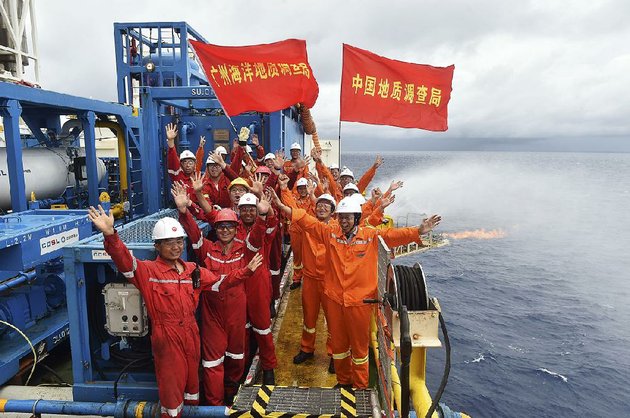Page added on May 20, 2017
China, Japan mine seas’ frozen gas

Commercial development of the globe’s reserves of a frozen fossil fuel known as “combustible ice” has moved closer to reality after Japan and China successfully extracted the material from the seafloor off their coastlines.
But experts said Friday that large-scale production remains many years away — and if not done properly could flood the atmosphere with climate-changing greenhouse gases.
Combustible ice is a frozen mixture of water and concentrated natural gas. Technically known as methane hydrate, it can be lit on fire in its frozen state and is believed to comprise one of the world’s most abundant fossil fuels.
The official Chinese news agency Xinhua reported that the fuel was successfully mined by a drilling rig operating in the South China Sea on Thursday. Chinese Minister of Land and Resources Jiang Daming declared the event a breakthrough moment heralding a potential “global energy revolution.”
A drilling crew in Japan reported a similar successful operation two weeks earlier, on May 4 offshore the Shima Peninsula.
For Japan, methane hydrate offers the chance to reduce its heavy reliance on imported fuels if it can tap into reserves off its coastline. In China, it could serve as a cleaner substitute for coal-burning power plants and steel factories that have polluted much of the country with lung-damaging smog.
The South China Sea has become a focal point of regional political tensions as China has claimed swaths of disputed territory as its own. Previous sea oil exploration efforts by China met resistance, especially from Vietnam, but its methane hydrate operation was described as being outside the most hotly contested areas.
Methane hydrate has been found beneath seafloors, and buried inside Arctic permafrost and beneath Antarctic ice. The United States and India also have research programs pursuing technologies to capture the fuel.
Estimates of worldwide reserves range from 10,000 trillion cubic feet up to 100,000 trillion cubic feet, according to the U.S. Energy Information Administration. By comparison, total worldwide production of natural gas was 124 billion cubic feet in 2015, the most recent year available.
That means methane hydrate reserves could meet global gas demands for 80 to 800 years at current consumption rates.
Yet efforts to successfully extract the fuel at a profit have eluded private and state-owned energy companies for decades. That’s in part because of the high cost of extraction techniques, which can use large amounts of water or carbon dioxide to flood methane hydrate reserves so the fuel can be released and brought to the surface.
Japan first extracted some of the material in 2013 but ended the effort due to sand from the seafloor clogging machinery, according to the country’s Ministry of Economy Trade and Tourism.
There are also environmental concerns.
If methane hydrate leaks during the extraction process, it can increase greenhouse gas emissions. The fuel also could displace renewables such as solar and wind power, said David Sandalow, a former senior official with the U.S. State Department now at Columbia University’s Center on Global Energy Policy.
However, if it can be used without leaking, it has the potential to replace dirtier coal in the power sector.
“The climate implications of producing natural gas hydrates are complicated. There are potential benefits, but substantial risks,” Sandalow said.
Commercial-scale production could be “transformative for northeast Asia, particularly for Japan, which imports nearly all its hydrocarbon needs,” said James Taverner, a senior energy industry researcher at IHS Market, a London-based consulting firm.
The consensus within the industry is that commercial development won’t happen until at least 2030. Smaller scale output could happen as early as 2020, said Tim Collett, a scientist with the U.S. Geological Survey.
“The path to understanding when or if gas hydrates will be commercially produced will need many similar and more extended testing efforts,” Collett said.
7 Comments on "China, Japan mine seas’ frozen gas"


dave thompson on Sat, 20th May 2017 4:22 pm
“The consensus within the industry is that commercial development won’t happen until at least 2030.” Oh well so much for gas hydrates.
Go Speed Racer on Sat, 20th May 2017 4:54 pm
I heard its another fake-out.
Go grab a chunk of it, but bring it to the
surface and it will disappear.
If you drill into it, once it starts melting
the bore hole will be unstable and it all leak away.
This just another bogus energy project pays
the participants some salaries keeps their
kids loaded up with swing sets and college funds
BUT it does not work, just like fusion does not work.
rockman on Sat, 20th May 2017 10:53 pm
Racer – “If you drill into it, once it starts melting the bore hole will be unstable and it all leak away.” And that’s the problem I have conceptualizing the process: you’re flowing not flowing NG out of the pore in a rock: you’re mining a potentially large volumes of solid material which would create a giant cavern. Difficult to imagine that wouldn’t be extremely unstable.
Go Speed Racer on Sun, 21st May 2017 1:15 am
Thx Mr Rockman, I figured U would
know for sure. Well, then hydrates is
just another scam like fusion.
I think our society is gonna run outta
oil real soon and it’s gonna be an
incredible mess. However am thinking
the rich folks will always get their oil so
it will amplify effects of rich vs poor.
Cloggie on Sun, 21st May 2017 6:25 am
Methane hydrates, yet another important potential element of the Third Carbon Age…
http://www.truth-out.org/news/item/18060-the-third-carbon-age-dont-for-a-second-imagine-were-heading-for-an-era-of-renewable-energy
…an age that should be buried as soon as possible.
Cloggie on Mon, 22nd May 2017 4:51 am
320 offshore 5 MW wind turbines suffice to power 8 million cars in the Netherlands by 2030:
https://deepresource.wordpress.com/2017/05/22/wind-power-and-electric-vehicles/
And then there are still people who don’t believe in a renewable energy future.
Davy on Mon, 22nd May 2017 5:30 am
“And then there are still people who don’t believe in a renewable energy future.”
There are people that question how we are going to get to a renewable future by 2030. Maybe it would be better to say “There are people who say we are going to have a renewable future who live in that future now and disregard current problems.” These type people reminds me of the businesses with the grand visions of growth that go bankrupt because their business plan was not realistic.
This is just more happy ending stuff that dismisses the problems we have right now. These problems are predicaments that a renewable future will not solve because there are no solution. I am happy these efforts are occurring. They are good trends for the decline ahead. I am not going to be deceived and enamored by this fictional future as that solution that saves us. If for some reason it happens I am saying wonderful. I will be happy to be wrong but when it doesn’t happen I will already be prepared for the worst.